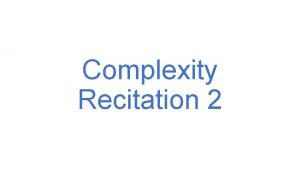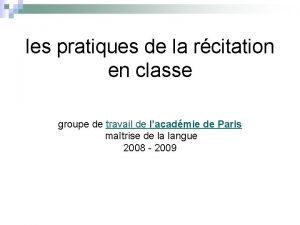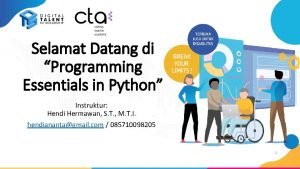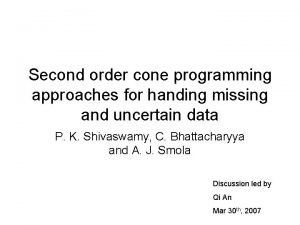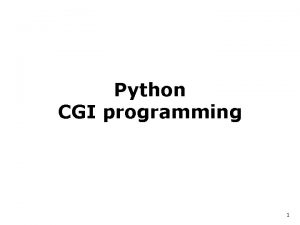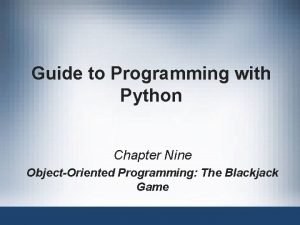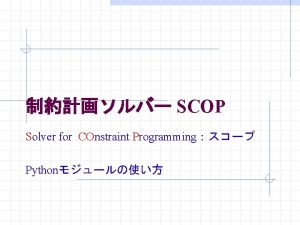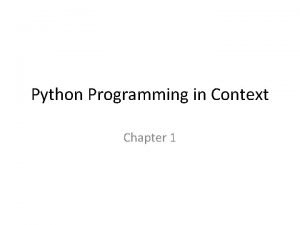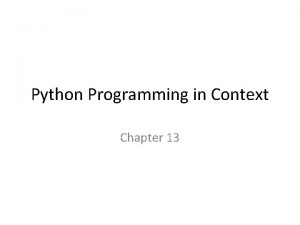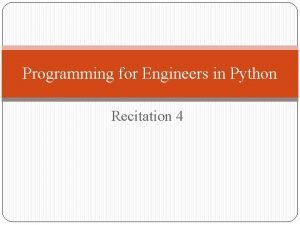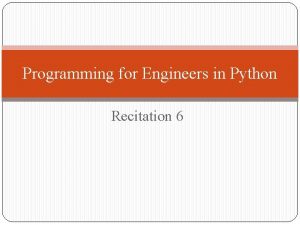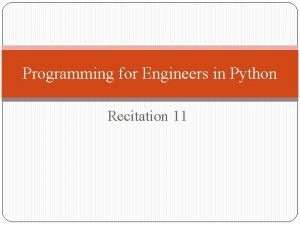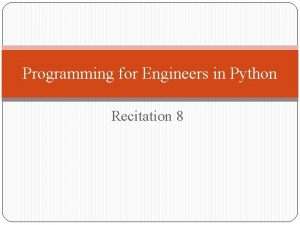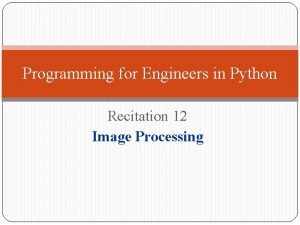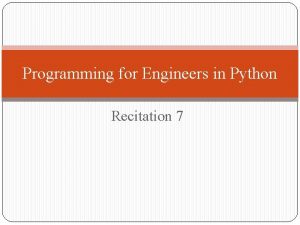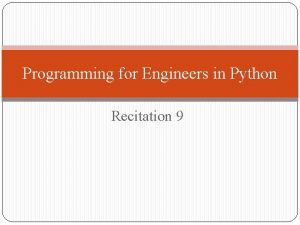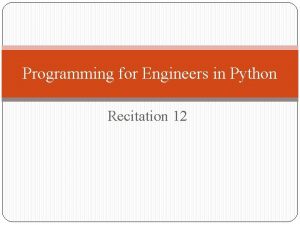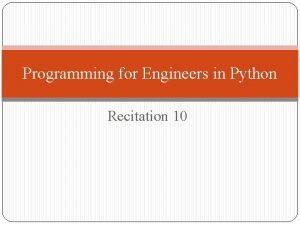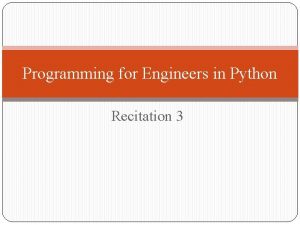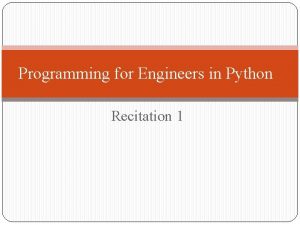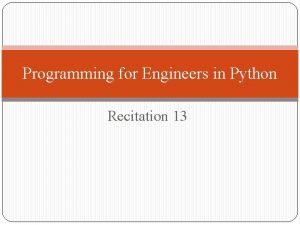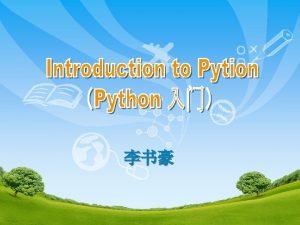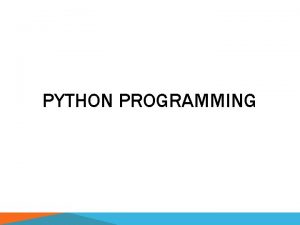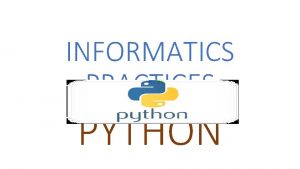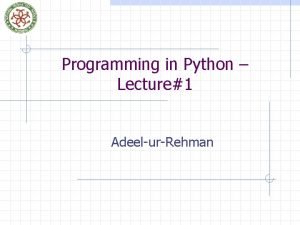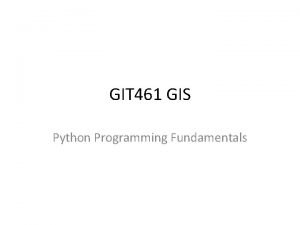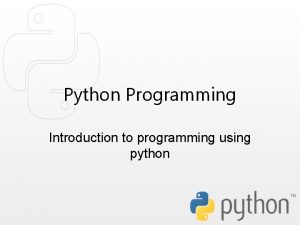Programming for Engineers in Python Recitation 5 Agenda



![Notes on birthday problem >>> s = t[: ] �Creates a copy of t Notes on birthday problem >>> s = t[: ] �Creates a copy of t](https://slidetodoc.com/presentation_image_h2/cfc4d4e966c96a33278a78cb038c4709/image-4.jpg)


![Dictionary “implementation” >>> dic = {“yoav” : “ram”, “noga” : “levy”} >>> dic[“yoav”] ‘ram’ Dictionary “implementation” >>> dic = {“yoav” : “ram”, “noga” : “levy”} >>> dic[“yoav”] ‘ram’](https://slidetodoc.com/presentation_image_h2/cfc4d4e966c96a33278a78cb038c4709/image-7.jpg)
![Why must dictionary keys be immutable? key= [1, 2, 3] We want this mapping Why must dictionary keys be immutable? key= [1, 2, 3] We want this mapping](https://slidetodoc.com/presentation_image_h2/cfc4d4e966c96a33278a78cb038c4709/image-8.jpg)




![Frequency Counter # print for char. Tuple in sorted. Char. Tuples: print char. Tuple[0] Frequency Counter # print for char. Tuple in sorted. Char. Tuples: print char. Tuple[0]](https://slidetodoc.com/presentation_image_h2/cfc4d4e966c96a33278a78cb038c4709/image-13.jpg)














- Slides: 27

Programming for Engineers in Python Recitation 5

Agenda �Birthday problem �Hash functions & dictionaries �Frequency counter �Object Oriented Programming 2

Random Birthday Problem �What are the odds that two people will have the same birthday? (1/365~0. 27%) �In a room with 23 people what are the odds that at least two will have the same birthday? (~50%) �In a room with n people, what are the odds? http: //www. greenteapress. com/thinkpython/code/bir thday. py See “Think Python” book for problems and solutions! 3
![Notes on birthday problem s t Creates a copy of t Notes on birthday problem >>> s = t[: ] �Creates a copy of t](https://slidetodoc.com/presentation_image_h2/cfc4d4e966c96a33278a78cb038c4709/image-4.jpg)
Notes on birthday problem >>> s = t[: ] �Creates a copy of t in s – changing t will not change s! >>> random. randint(a, b) �Returns an integer between a and b, inclusive 4

Hash functions �Gets a BIG value and returns a SMALL value �Consistent: if x==y then hash(x)==hash(y) �Collisions: there are some x!=y such that hash(x)==hash(y) 5 http: //en. wikipedia. org/wiki/Hash_function

Hash functions >>> hash("yoav") 1183749173 >>> hash(“noga") 94347453 >>> hash(1) 1 >>> hash(“ 1") 1977051568 6
![Dictionary implementation dic yoav ram noga levy dicyoav ram Dictionary “implementation” >>> dic = {“yoav” : “ram”, “noga” : “levy”} >>> dic[“yoav”] ‘ram’](https://slidetodoc.com/presentation_image_h2/cfc4d4e966c96a33278a78cb038c4709/image-7.jpg)
Dictionary “implementation” >>> dic = {“yoav” : “ram”, “noga” : “levy”} >>> dic[“yoav”] ‘ram’ �What happens under the hood (roughly): >>> hashtable = [] >>> hashtable[hash(“yoav”)]=“ram” >>> hashtable[hash(“noga”)]=“levy” >>> hashtable[hash(“yoav”)] ‘ram’ 7 For a detailed explanation: www. laurentluce. com/posts/python-dictionary-implementation/
![Why must dictionary keys be immutable key 1 2 3 We want this mapping Why must dictionary keys be immutable? key= [1, 2, 3] We want this mapping](https://slidetodoc.com/presentation_image_h2/cfc4d4e966c96a33278a78cb038c4709/image-8.jpg)
Why must dictionary keys be immutable? key= [1, 2, 3] We want this mapping hash(…) ed t n e is h t y m i app ‘shakshuka’ ng b m hash(key)= 5863 8 le p m I http: //pyfaq. infogami. com/why-must-dictionary-keys-be-immutable

Why must dictionary keys be immutable? We change an entry in the key: >>> key[0]=1000 But it doesn’t change the mapping! Now, key doesn’t map to the value! key= [1000, 2, 3] ‘shakshuka’ This is the mapping we have hash(…) hash(key)= 9986 9 We want this mapping hash(key)= 5863 http: //pyfaq. infogami. com/why-must-dictionary-keys-be-immutable

Why must dictionary keys be immutable? � Consider using a list as a key (this is NOT a real Python code!) >>> key = [1, 2, 3] >>> hash(key) # assuming key was hashable – it is not! 2011 >>> dic = {key : “shakshuka”} # hashtable[2011] = “shakshuka” >>> key[0] = 1000 >>> hash(key) 9986 >>> dic[key] # hashtable[1983] Traceback (most recent call last): File "<pyshell#12>", line 1, in <module> dic[key] Key. Error: ‘[1000, 2, 3]‘ � The key [1000, 2, 3] doesn’t exist! 10 http: //pyfaq. infogami. com/why-must-dictionary-keys-be-immutable

Frequency Counter § Substitution cyphers are broken by frequency analysis § So we need to learn the frequencies of English letters § We find a long text and start counting § Which data structure will we use? supercalifragilisticexpialidocious 11

Frequency Counter str 1 = 'supercalifragilisticexpialidocious‘ # count letters char. Count = {} Returned if char is not in the dictionary for char in str 1: char. Count[char] = char. Count. get(char, 0) + 1 # sort alphabetically sorted. Char. Tuples = sorted(char. Count. items()) 12
![Frequency Counter print for char Tuple in sorted Char Tuples print char Tuple0 Frequency Counter # print for char. Tuple in sorted. Char. Tuples: print char. Tuple[0]](https://slidetodoc.com/presentation_image_h2/cfc4d4e966c96a33278a78cb038c4709/image-13.jpg)
Frequency Counter # print for char. Tuple in sorted. Char. Tuples: print char. Tuple[0] , ‘ = ‘, char. Tuple[1] a=3 c=3 d=1 e=2 f= 1 g=1 … 13

The Table Does Not Lie �We will construct a dictionary that holds the current table of the basketball league and a function that changes the table based on this week results �Initialize the table: >>> table = {} >>> for team in team_list: table[team] = 0 >>> table {'jerusalem': 0, ‘tel-aviv': 0, 'ashdod': 0, …} 14

Changing the table �League results is a list of tuples - (winner, loser): >>> results= [(“galil”, ”tel-aviv”), ( “herzelia”, ”ashdod”), …] �We define a function to update the league table: def update_table(results): for winner, loser in results: table[winner] = table[winner]+2 table[loser] = table[loser]+1 15

Comparing teams � The table must be sorted by points, we need a 16 compare function: def cmp_teams(team 1, team 2): point. Cmp = cmp(team 1[1], team 2[1]) if point. Cmp != 0: return point. Cmp else: return -cmp(team 1[0], team 2[0]) >>> cmp_teams(('galil', 2), ('ashdod', 1)) 1 >>> cmp_teams(('galil', 2), ('ashdod', 2)) -1 >>> cmp_teams(('galil', 2), ('tel-aviv', 2)) 1

Showing the table � The table must be sorted by points, in descending order: >>> s_teams = sorted(table. items(), cmp_teams, reverse=True) >>> for team, points in s_teams: print points, "|", team. capitalize() 2 | Galil 2 | Herzelia 2 | Jerusalem 1 | Ashdod 1 | Tel-aviv 17

Object Oriented Programing �Started in class – more next week �Model human thinking �We perceive the world as objects and relations �Encapsulation �Keep data and relevant functions together �Modularity �Replace one part without changing the others �Reusability �Use the same code for different programs �Inheritance �Extend a piece of code without changing it 18

Objects 19

Classes � Definition class Class. Name (object): statement 1 statement 2. . . � Initialization >>> foo = Foo() >>> foo # this is an instance of class Foo <__main__. Foo instance at 0 x 01 C 60530> >>> type(foo) <type 'instance'> 20

__init__ - the constructor �__init__ is used to initialize an instance �Can have arguments other than self class Student(): def __init__(self, name): self. name = name >>> student = Student(‘Yossi') >>> student. name ‘Yossi' 21

self �self is a reference to the instance itself �Used to refer to the data and methods �The first argument of a method is always self, but there’s no need to give it to the method 22

self – cont. 23 class Class. Example(): def get_self(self): return self >>> example = Class. Example() >>> example <__main__. Class. Example instance at 0 x 01 C 00 A 30> >>> example. get_self() <__main__. Class. Example instance at 0 x 01 C 00 A 30> >>> Class. Example. get_self(example ) <__main__. Class. Example instance at 0 x 01 C 00 A 30> >>> Class. Example. get_self() Traceback (most recent call last): File "<pyshell#15>", line 1, in <module> Class. Example. get_self() Type. Error: unbound method get_self() must be called with Class. Example instance as first argument (got nothing instead)

Example – Bank Account � Code: https: //gist. github. com/1399827 24 class Bank. Account(object): def __init__(self, initial_balance=0): self. balance = initial_balance def deposit(self, amount): self. balance += amount def withdraw(self, amount): self. balance -= amount def is_overdrawn(self): return self. balance < 0 >>> my_account = Bank. Account(15) >>> my_account. withdraw(5) >>> my_account. deposit(3) >>> print “Balance: ”, my_account. balance, ”, Overdraw: ”, my_account. is_overdrawn() Balance: 13 , Overdraw: False

Multimap �A dictionary with more than one value for each key �We already needed it once or twice and used: >>> lst = d. get(key, []) >>> lst. append(value) >>> d[key] = lst �Now we create a new data type 25

Multimap � Use case – a dictionary of countries and their cities: >>> m = Multimap() >>> m. put('Israel', 'Tel-Aviv') >>> m. put('Israel', 'Jerusalem') >>> m. put('France', 'Paris') >>> m. put_all('England', ('London', 'Manchester', 'Moscow')) >>> m. remove('England', 'Moscow') >>> print m. get('Israel') ['Tel-Aviv', 'Jerusalem'] Code: https: //gist. github. com/1397685 26

Advanced example: HTTP Server �We will write a simple HTTP server �The server allows to browse the file system through the browser �Less than 20 lines, including imports! �Code: https: //gist. github. com/1400066 �Another one - this one writes the time and the server’s IP address: https: //gist. github. com/1397725 27
 Introduction to matlab for engineers
Introduction to matlab for engineers Quood posture 8 in english
Quood posture 8 in english What is meant by etiquette of recitation of the holy quran
What is meant by etiquette of recitation of the holy quran Is the rote recitation of a memorized written message
Is the rote recitation of a memorized written message Recitation les machines
Recitation les machines Objectives of poem recitation
Objectives of poem recitation Process-oriented learning competencies
Process-oriented learning competencies Active recitation
Active recitation Tips for reciting poetry
Tips for reciting poetry 100belaud
100belaud Agenda sistemica y agenda institucional
Agenda sistemica y agenda institucional Programming essentials in python
Programming essentials in python Second order cone programming python
Second order cone programming python Cgi python
Cgi python Python object oriented programming blackjack
Python object oriented programming blackjack Constraint programming python
Constraint programming python Python programming in context
Python programming in context Audiolab python
Audiolab python Python procedural programming
Python procedural programming Python programming an introduction to computer science
Python programming an introduction to computer science Rapid gui programming with python and qt
Rapid gui programming with python and qt Python str
Python str Python chapter 5 programming exercises
Python chapter 5 programming exercises Python programming in context
Python programming in context Greedy algorithm vs dynamic programming
Greedy algorithm vs dynamic programming Definition of system programming
Definition of system programming Linear vs integer programming
Linear vs integer programming Perbedaan linear programming dan integer programming
Perbedaan linear programming dan integer programming




